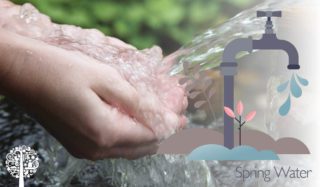Every water source has a distinctive profile that interplays with your soil/substrate and plants. It can be complicated to unravel all the variables affecting your water. Still, there are some basics we can learn about each water source type, what their most common issues are, and the strategies for detecting and dealing with potential crop health factors the water sources may be causing.
Municipal Water Source –Disinfectants and Fluoride
You would think issues with a municipal water source are much less likely to exist. This is true, to some degree, because our municipal water sources have been cleaned of any biological contamination. Still, the process of water treatment does not result in totally clean, empty water. It uses disinfectants, either chlorine or chloramine, and often, municipalities add fluoride to the water as well.

Disinfectants used in water treatment can concern gardeners, especially gardeners focused on building soil biology. Your management approach will depend on which disinfecting agent is used. Often your municipality’s website will have the annual drinking water quality report posted. If not, call your city and inquire about receiving a copy of this report, which will provide the details on which disinfectant they are using (chlorine or chloramine) and whether fluoride is added to the water.
Chlorine is a much more unstable molecule than chloramine, thus much easier to remove. It evaporates quickly from water when aerated and can be captured and bound up by humic acid when added to chlorinated water. On the other hand, chloramine has an ammonia ion stacked into its molecular form, which creates more stability, so it is much less prone to breaking down and stays active in the water longer. Granular activated carbon filters and reverse osmosis systems are the most effective for removing chloramines.
Fluoride can also be an issue in the garden, even at low levels. Fluoride is not an essential plant nutrient, and it accumulates in a plant over time. If fluoride accumulates too heavily in your plants, it can inhibit photosynthesis and cause damage to your plants. If you do not know whether your city adds fluoride, give them a call, or go dig up that water quality report to see if it is added. Reverse osmosis systems are the most effective for removing fluoride.
Well Water – Geology and Mineral Profile
Geology plays a massive role in the water quality found in a particular well and is reflected in the mineral profile. Therefore, routine water testing will help sidestep potential nutrient issues with your crops.
Well water can also change from year to year and throughout the year– a drought year versus non-drought, the dry season versus the rainy season. Monitoring your well water in different seasons will give you great information on how it may change or impact your garden or farm throughout the year.

Newly drilled wells have a much higher level of mineral content. This heightened mineral content will persist for the first few years after drilling. If you have a new well, it should be tested regularly to track how this profile settles out over time.
Pond Water Source – Pollution, Mineral Profile, and Algae Growth
Since ponds collect water that has moved over a landscape, the surrounding environment may negatively impact its quality. A good starting point is to test pond water for potential contaminants such as herbicides or petroleum-based residues, as well as the pH and mineral make-up.
If you have a deeper pond, be aware that as the growing season progresses, the lower depths of your pond may become anoxic, meaning oxygen-free. This can cause the mobilization of certain metals, like manganese and iron. Oxygen-deprived water causes these minerals typically bound to the soil sediment to become soluble. Testing your pond water at different points in the season will help you understand how the mineral profile might fluctuate throughout the year.

Algae growth is another common pond water issue, and there are two common ways of dealing with it. First, you can install pond aerators to increase oxygen in your pond water, which will arrest the algal growth rate. However, aeration is not often economically viable as it can be expensive and require maintenance.
Another option for algae control is decomposing barley straw in your pond water or applying barley straw extracts. This method has proven successful in clarifying ponds, although there can be some limitations to its application. For instance, if a pond is heavily loaded with nutrients and has the right light exposure and temperature parameters, this will be the perfect environment for supporting algae growth. The barley straw extract on its own may not be powerful enough to combat the algae. In these cases, using aeration and barley extracts together may be more effective to produce algae-free results.
Spring Water – Spring Type, Biology, and Mineral Profile
There are many different types of springs – depression springs, fracture springs, Karst springs, fault springs, or contact springs. They are all defined by geology, subsurface location, and landscape position. Springs are site-specific, so it is best to distinguish what type is occurring to unravel its influences and assess water quality risks.
Spring water is essentially a shallow groundwater source, and quality issues center mostly around biological contaminants from surface contamination. If you are considering using spring water, it is wise to have it tested for biological hazards like E. coli and fecal coliform. Spring water should also be tested for Giardia and Cryptosporidium if you are drinking or irrigating food or livestock.

Like well and pond water, geology plays a central role in the mineral profile of spring water. Testing will help you understand how to manage any potential issues your crops or equipment may face. Additionally, just like the other natural water sources, spring water can change from year to year and throughout the year. Therefore, monitoring water quality at different times of year will provide good information on water quality fluctuations.
Water quality issues are extensive and heavily dependent on site-specific factors, but it all starts with getting to know your watershed and its geology. Building an understanding of your local environment and its unique qualities will help you successfully manage the limitations of any water source.